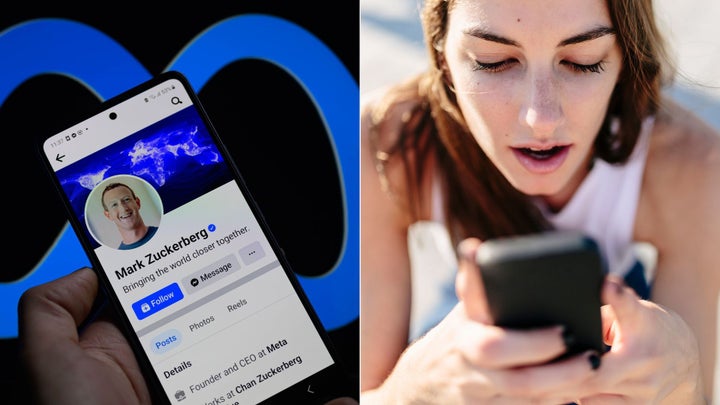
Facebook wants us all to start “poking” again.
On Tuesday, the tech company said that it has been redesigning the platform to make its poke feature significantly more prominent. The new design surfaces the button alongside any name that a user has searched, making poking as easy as it was back in the olden days of 2011.
For those who need a refresher, the poke feature is basically a virtual nudge ― you know, a poke! ― that you can send to another user. They get a notification and poke back, if they’re so inclined.
Technically, the poke button never really disappeared; as tech reporter Katie Notopoulos wrote for Business Insider, the feature was just so hidden that you’d need to type “poke” into the Facebook search bar to find it, or bookmark the poke page’s exact URL.

But while the poke button accumulated dust for the rest of us, Gen Zers are apparently really into it now. Facebook said that the superficial changes to its design have caused poking to become 13 times more common in the past month, with more than 50% of pokes coming from 18- to 29-year-olds who’d missed out on the earlier era of poking.
As any millennial will tell you, poking was a polarising feature among early Facebook users; while some kept their poke wars going for years, the feature was off-putting to many, especially women. To some, it felt like the digital equivalent of “where’s my hug?” coming from the guy you’d least like to hug.
“At its peak in the mid-2000s ― 2009-2011-ish, from my recollection ― the poke feature was almost exclusively used by men toward women they didn’t know very well,” remembers 31-year-old Aly, a co-host of the “Let’s Get Haunted” podcast.
“I have visceral memories of checking my social media before school and finding that my art history T.A. [teaching assistant], a random guy I’d met at a party or my manager at work had poked me at 2 a.m.,” she told HuffPost.
“To this day I don’t know if people thought they were being smooth or creative, but at the time it was almost always interpreted as corny or awkward by the receiver,” she said. “But Gen Z is good at subverting the corny and making it cool, so more power to them!”
Shockingly, sometimes poking-as-flirting actually worked. Ever the evangelist for his own tech, Facebook co-founder Mark Zuckerberg acknowledged this week that he was a bit of a poke guy back in the day. In fact, it’s how he made one of his first moves on future wife Priscilla Chan, and she was swayed! (Girl, come on.)
Other times, poke flirtation went entirely over people’s heads.
“I had this high school classmate who I’d constantly poke back and forth with well into our college years. But being an oblivious young adult, I had no idea that she was probably flirting with me,“ said Azad Yakatally, the 35-year-old head of social media at Klaviyo, a software company focused on email marketing for e-commerce.
“A lot later in life it kind of clicked, and boy did I wish I realised that at the time,” he said. “To me, [poking] is so reflective of the early days of social media, when no one really knew what we were doing or what was going on.”
Others used the poke feature as a low-effort way to keep in touch with friends and family in far-off places ― a sort of digital “wave” hello to remind a person that you still exist.
“In theory, I loved the idea of a low-pressure way to say hi to my friends,” said Maggie Mae Fish, a 31-year-old actor. “I think that’s definitely the appeal. And it makes sense that Gen Z embraces its charm, especially now that social media now includes so much pressure to perform.”
Jesse J. Anderson, the author of “Extra Focus: The Quick Start Guide to Adult ADHD,” thinks the feature probably helped him maintain friendships for years longer than he does now.
“Everyone made jokes about the poke button, but we all still used it, too,” the 43-year-old said.
“So much of social media has become very self-serious or trollish and mean-spirited. I'm all for bringing back silly social.”
- Jesse J. Anderson, the author of "Extra Focus: The Quick Start Guide to Adult ADHD"
Eventually, Facebook’s bloated suite of features and capabilities overshadowed the poke button, and most of us just forgot about it.
“Once Facebook added direct messaging, you could just reach out and connect with the people you wanted to talk to,” said Lia Haberman, a Gen Xer who writes a social media marketing newsletter called ICYMI. (It’s hard to believe, she said, but messaging wasn’t baked into the platform when it first launched.)
There was an attempt to revive the poke in 2017, but it didn’t catch on. This time around, Gen Zers’ enthusiasm about the feature may change that.
“It’s wild that Gen Z’s rediscovered the poke and is actually using it,” Haberman said.
Millennials and Gen Xers may scoff at the feature ― boomers are too busy engaging in poke wars they began in 2011 ― but Anderson thinks the return of the feature is ultimately a refreshing and welcome blast from the past.
“Bring back the silly, carefree internet!” he said. “So much of social media has become very self-serious or trollish and mean-spirited. I’m all for bringing back silly social. Maybe we can bring back blogrolls, Winamp skins, and Strong Bad emails while we’re at it?”